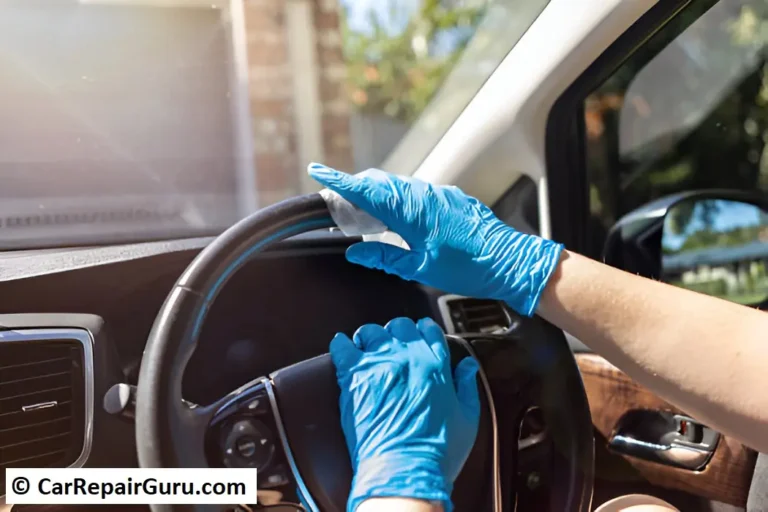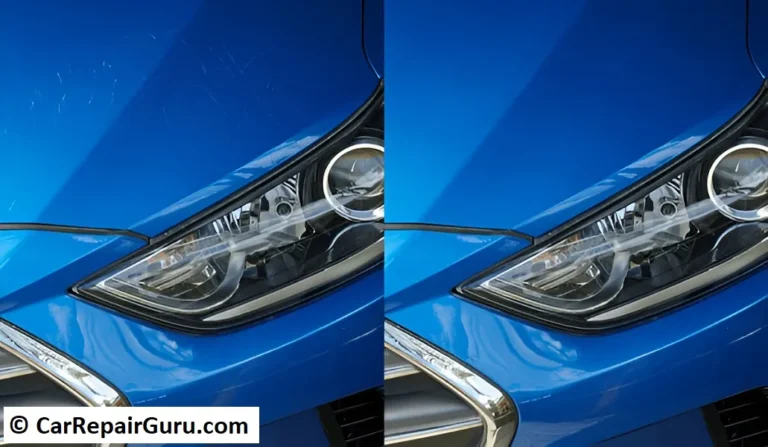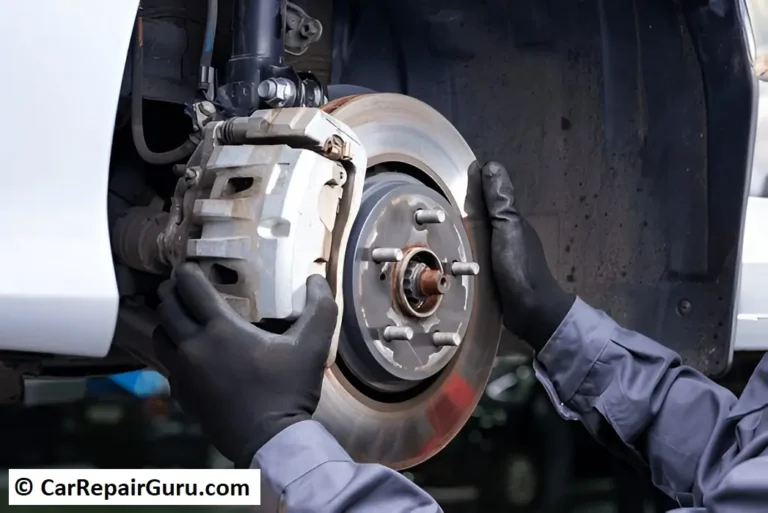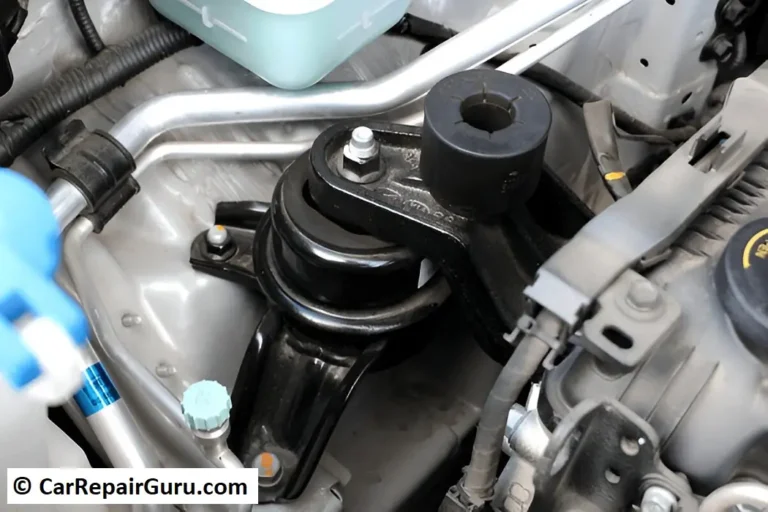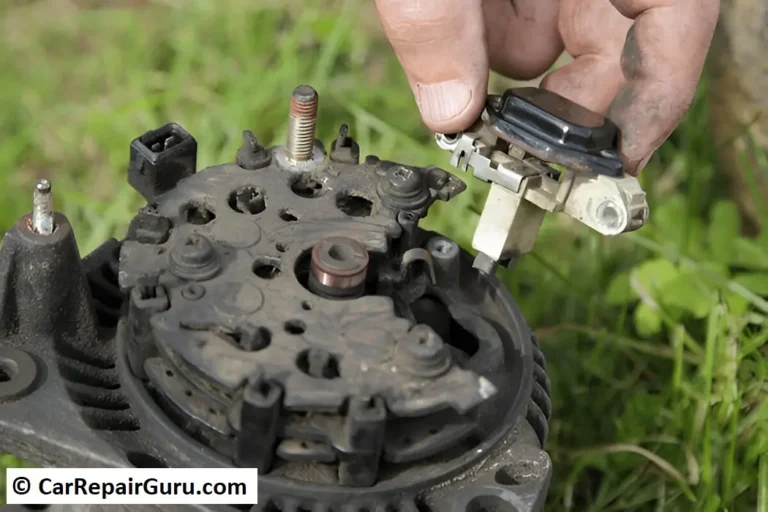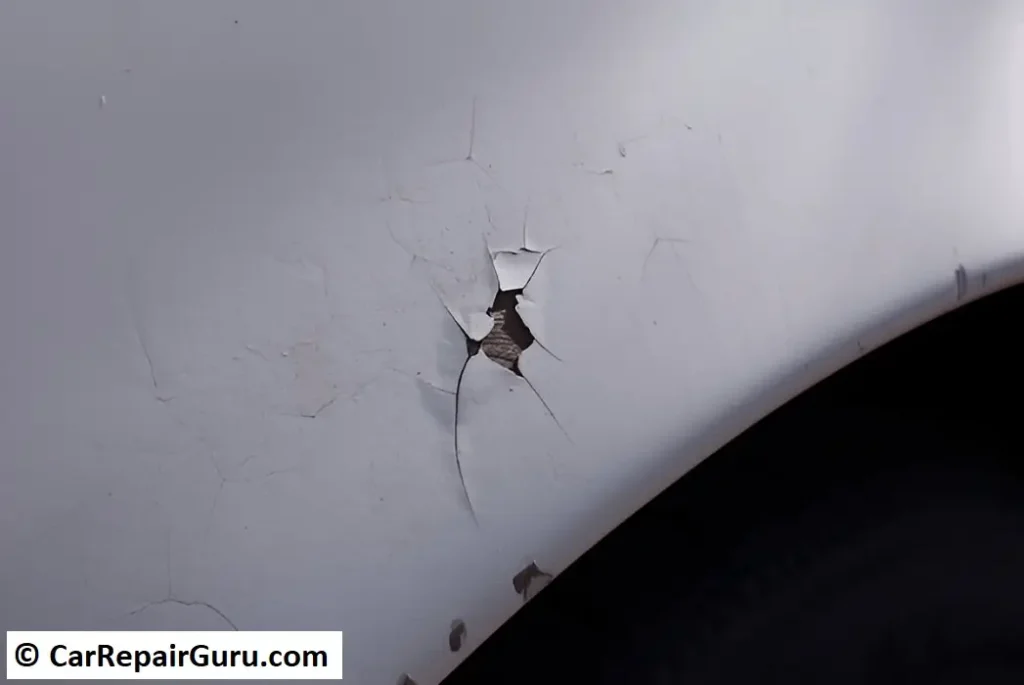
Chipped car paint might seem like a minor issue, but it can lead to significant problems over time. Exposed metal beneath the paint is vulnerable to rust, which not only affects the look of your car but also its structural integrity. Repairing chipped paint doesn’t have to be expensive or overwhelming. With the right tools and steps, you can restore your car’s appearance and protect it from further damage. Whether you’re tackling a DIY repair or considering professional services, this guide is your ultimate resource for fixing chipped car paint efficiently.
Understanding Paint Chips
What Causes Paint Chips?
Chipped car paint is often the result of everyday driving conditions. Here are the main culprits:
- Gravel and Road Debris
Small stones and gravel can be propelled by tires, creating tiny impacts that chip away at the car’s paint. This is especially common on highways or gravel roads. - Weather Conditions
Extreme temperatures, hailstorms, and UV exposure weaken paint over time. In cold climates, road salt used to de-ice roads can also corrode the paint, making it more prone to chipping. - Accidents and Minor Scratches
Door dings, minor collisions, or scraping against objects can cause chips in the paint layer. These small damages might seem insignificant but can have long-term effects.
Why Fix Them Quickly?
Ignoring chipped paint can lead to several issues:
- Rust Formation
Once the protective paint layer is compromised, the exposed metal underneath reacts with moisture and oxygen, leading to rust. Rust spreads quickly and can weaken the car’s structure. - Decreased Vehicle Resale Value
Visible damage, even minor chips, can reduce your car’s appeal to potential buyers. Fixing the paint keeps the vehicle looking well-maintained and increases its value.
Addressing paint chips early ensures your car remains protected and visually appealing, saving you from costly repairs later.
Tools and Materials for Repair
Essential Items for Repair
To repair chipped car paint effectively, you’ll need the following tools and materials:
- Touch-Up Paint
- Specifically matched to your car’s color to ensure seamless blending.
- Sandpaper
- Fine-grit sandpaper (e.g., 600-1200 grit) smooths rough edges around the chip and prepares the surface for painting.
- Primer
- Used to create a base layer that helps the paint adhere properly to the surface.
- Microfiber Cloth
- Ideal for cleaning and drying the area without leaving scratches or lint.
How to Choose the Right Paint Color
Finding the perfect match for your car’s paint is crucial for a professional-looking repair. Here’s how to do it:
- Locate the Paint Code
- Check your car’s manual, the driver-side door jamb, or under the hood for a sticker displaying the paint code.
- Buy the Exact Match
- Use the paint code to purchase touch-up paint from your car manufacturer or an auto parts store.
- Test Before Application
- Always test the paint on a small, hidden section of your car to ensure an exact match.
Using the right tools and color ensures the repair blends seamlessly, maintaining your car’s flawless appearance.
Step-by-Step Guide to Fixing Chipped Car Paint
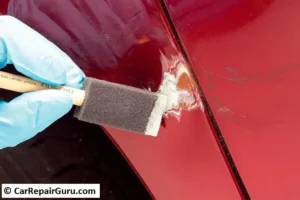
1. Clean the Area
Start by thoroughly cleaning the chipped area to remove any dirt, debris, or grease. Use mild soap and warm water, scrubbing gently with a sponge. Ensure the surface is spotless, as any contaminants can prevent the paint from adhering properly. After washing, dry the area completely using a microfiber cloth. A clean surface is essential to achieving a smooth and durable repair.
2. Prepare the Surface
Once the area is clean, inspect the chip’s edges. Use fine-grit sandpaper (600-1200 grit) to smooth the chipped edges. Sanding helps remove loose paint and creates a smooth transition between the damaged and intact paint. Be careful not to over-sand, as this could enlarge the chip.
If bare metal is exposed, apply a thin layer of primer using a small brush or applicator. The primer ensures the paint adheres properly and prevents rust from forming. Let the primer dry completely before moving on to the next step.
3. Apply the Touch-Up Paint
Using a color-matched touch-up paint, begin by applying thin, even layers to the chipped area. Shake the paint bottle well before use to mix the pigments thoroughly.
Use a fine-tip applicator or brush for precision. Start from the center of the chip and work outward, filling the area carefully. Avoid overloading the brush, as thick layers can lead to uneven drying.
Allow each coat to dry for 10-20 minutes before applying the next layer. Depending on the depth of the chip, you may need 2-3 coats to fully cover the damage. Patience is key to achieving a smooth finish.
4. Seal with a Clear Coat
Once the touch-up paint is dry, seal it with a clear coat to protect the repaired area. Apply a thin layer of clear coat using a clean brush or applicator, ensuring full coverage of the repaired spot.
The clear coat adds a glossy finish and shields the paint from UV rays, moisture, and future damage. Let the clear coat cure for at least 24 hours to ensure maximum durability.
5. Buff and Polish
After the clear coat has fully cured, use a soft cloth and car polish to buff the repaired area. This step blends the touch-up paint with the surrounding surface, creating a smooth and seamless look.
Buffing is essential for a professional finish when fixing chipped car paint, enhancing the overall appearance.
This step-by-step guide ensures that fixing chipped car paint is easy to follow and yields professional results, restoring your car’s aesthetic and protecting its value.
When to Seek Professional Help
Signs That Require Professional Intervention
While minor paint chips can often be fixed at home, there are situations where professional assistance is necessary:
- Large or Deep Chips
If the damage covers a significant area or goes beyond the paint layer into the metal, professional expertise is required to ensure proper repair. - Rust Damage
If the chipped area has already developed rust, it can spread quickly and compromise the car’s structure. Professionals have the tools and knowledge to address rust and prevent further corrosion. - Complex Paint Finishes
Metallic or pearlescent paints are challenging to match and require specialized equipment.
Benefits of Professional Services
- Precise Color Matching
Professionals use advanced tools, such as spectrophotometers, to perfectly match your car’s paint color, ensuring a seamless repair. - Durable Results
Professional repairs often come with high-quality finishes and warranties, providing long-term protection. - Time Efficiency
Experts complete the repair quickly, saving you the hassle of doing it yourself.
Seeking professional help ensures the best results, especially for severe or complex damage.
Preventing Future Paint Chips

Use Protective Films and Wax Coatings
Applying a clear protective film to your car’s paint can shield it from gravel, road debris, and minor impacts that cause chips. These films are durable, invisible, and particularly useful for high-impact areas like the hood and bumpers.
Wax coatings are another effective barrier. Regular waxing creates a slick surface that reduces friction and protects the paint from environmental elements, including UV rays and road grime.
Practice Careful Driving and Parking Habits
- Avoid Gravel Roads
When possible, avoid driving on gravel roads or areas with loose debris. If unavoidable, maintain a slower speed to minimize impact. - Maintain a Safe Following Distance
Staying farther behind other vehicles reduces the chances of being hit by debris thrown from their tires. - Park Smart
Avoid tight spaces where doors or objects may scratch your car. Choose shaded parking areas to reduce sun damage that weakens paint.
By following these tips, you can significantly reduce the risk of future paint chips and keep your car looking pristine.
Conclusion
Fixing chipped car paint is a straightforward process when broken down into clear steps: clean the area, prepare the surface, apply touch-up paint, seal with a clear coat, and finish with buffing and polishing. Acting promptly prevents further damage like rust and ensures your vehicle maintains its value and appearance. Whether you tackle the repair yourself or seek professional help, keeping your car’s paint in good condition is an investment in its longevity and aesthetics. Protect your car from future chips with preventive measures like protective films and wax coatings.
Frequently Asked Questions (FAQ)
How long does it take to fix chipped car paint?
DIY repairs typically take 1–3 hours, depending on the size and complexity of the damage. Professional services may require more time, especially for larger or more detailed work.
Can I repair deep paint chips myself?
Yes, but deep chips may need additional steps, like applying filler before painting. For extensive or complex damage, professional repair ensures the best results.
What is the cost of fixing chipped car paint?
DIY methods are budget-friendly, costing $20–$50 for materials. Professional repairs vary widely, ranging from $100 to $500, depending on the extent of the damage.
How can I prevent future paint chips?
Use protective films, apply regular wax coatings, avoid rough terrain, and drive cautiously to minimize risk.
Is it necessary to apply a clear coat?
Yes, applying a clear coat is essential. It provides a glossy, protective finish that shields the paint from UV rays, moisture, and future chips.
